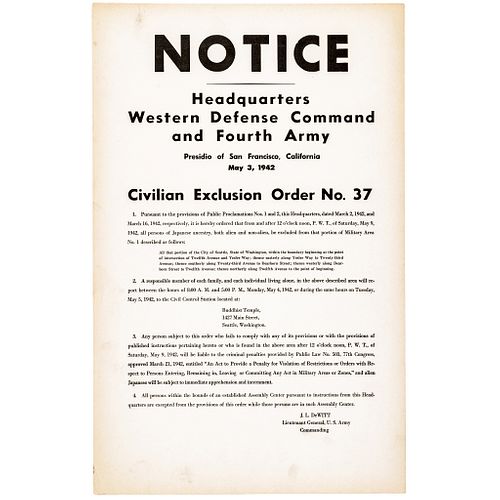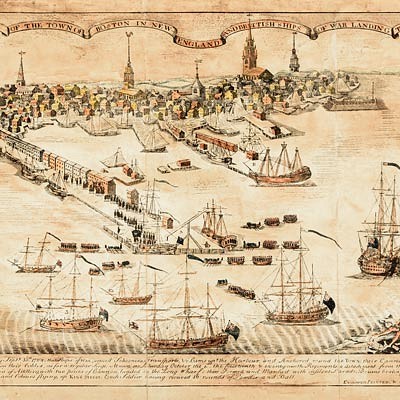1942 WW II JAPANESE-AMERICAN INTERMENT California U.S. Military Broadside Poster
Lot 286
About Seller
Early American History Auctions
1520 Commerce St., #312
Winchester, VA 22601
United States
Categories
Estimate:
$2,400 - $3,200
Absentee vs Live bid
Two ways to bid:
- Leave a max absentee bid and the platform will bid on your behalf up to your maximum bid during the live auction.
- Bid live during the auction and your bids will be submitted real-time to the auctioneer.
Bid Increments
| Price | Bid Increment |
|---|---|
| $0 | $10 |
| $200 | $20 |
| $300 | $25 |
| $500 | $50 |
| $1,000 | $100 |
| $2,000 | $200 |
| $3,000 | $250 |
| $5,000 | $500 |
| $10,000 | $1,000 |
| $20,000 | $2,000 |
| $30,000 | $2,500 |
| $50,000 | $5,000 |
| $100,000 | $10,000 |
| $200,000 | $20,000 |
| $300,000 | $25,000 |
| $500,000 | $50,000 |
About Auction
By Early American History Auctions
Mar 20, 2021
Set Reminder
2021-03-20 12:00:00
2021-03-20 12:00:00
America/New_York
Bidsquare
Bidsquare : Autographs-Colonial-Political-Americana
https://www.bidsquare.com/auctions/early-american-history-auctions/autographs-colonial-political-americana-6509
330 Lots of Rare, Historic Autographs, Americana, Civil War Era, George Washington, Abraham Lincoln, Slavery & Black History, Revolutionary War Era, Colonial America, Federal Period, War of 1812, Colonial Currency, Indian Peace Medals & more... Early American History Auctions auctions@earlyamerican.com
330 Lots of Rare, Historic Autographs, Americana, Civil War Era, George Washington, Abraham Lincoln, Slavery & Black History, Revolutionary War Era, Colonial America, Federal Period, War of 1812, Colonial Currency, Indian Peace Medals & more... Early American History Auctions auctions@earlyamerican.com
- Lot Description
Historic Americana
1942-Dated Historic WW II Japanese Ancestry-American "Internment" Official Broadside Poster San Francisco, Calif.
May 3, 1942-Dated World War II, Original Official JAPANESE-AMERICAN INTERMENT Broadside Poster Headed: "NOTICE" - Headquarters Western Defense Command and Fourth Army, Presidio of San Francisco, California. Civilian Exclusion Order No. 37," Choice Crisp Extremely Fine.
(Japanese Internment) Broaside, 1942 Japanese Internment Poster. Original World War II-era boldly printed on lightweight white coated cardboard, 14 x 22", dated May 3, 1942, officially issued by the Western Defense Command and Fourth Army Wartime Civil Control Administration. This is an original, boldly Printed Broadside/Poster measuring 22" x 14" in dark black on off-white cardstock, announcement regarding Japanese Internment in California, 1942. Issued by John L. DeWitt, Lieutenant General, U.S. Army, who administered the infamous "Japanese-American Internment" program in California. There is a printed list of four major specific points under "Order No. 37" to be followed. This historic Poster is remarkably choice, being in its original condition with only a faint spot at upper left. A highly important and currently quite timely, politically charged item!
Shortly after the attack on Pearl Harbor, President Franklin D. Roosevelt issued Executive Order 9066, authorizing the secretary of war to designate military zones within the U.S. from which "any or all persons may be excluded." The order was not targeted at any specific group, but it became the basis for the mass relocation and internment of some 110,000 Americans of Japanese ancestry, including both citizens and non-citizens of the United States.
In March 1942, Lieutenant General John L. DeWitt, commander of the U.S. Army Western Defense Command established a massive exclusion zone along the west coast and demanded that all persons of Japanese ancestry report to civilian assembly centers.
On short notice, thousands were forced to close businesses, abandon farms and homes, and move into remote internment camps, also called relocation centers. Some of the detainees were repatriated to Japan, and others moved eastward to other parts of the U.S. outside of the exclusion zones. A number even enlisted with the U.S. Army. But most simply endured their internment in frustrated resignation.
In January 1944, a Supreme Court ruling halted the detention of U.S. citizens without cause, and the exclusion order was rescinded, and the Japanese Americans began to leave the camps, most returning home to rebuild their former lives. The last camp closed in 1946, and by the end of the 20th century the U.S. government had paid $1.6 billion in reparations to detainees and their descendants.
Our Auction Contents:
Black History & Slavery: (Lots 1 - 63)
Abraham Lincoln Related: (Lots 64 - 74)
Historic Autographs: (Lots 75 - 235)
Colonial America: (Lots 236 - 261)
Revolutionary War: (Lots 262 - 304)
George Washington Related: (Lots 305 - 306)
Early American Guns & Weapons: (Lots 307 - 318) - Shipping Info
-
Early American provides in-house worldwide shipping. Please contact us directly if you have questions about your specific shipping requirements.
-
- Buyer's Premium



 EUR
EUR CAD
CAD AUD
AUD GBP
GBP MXN
MXN HKD
HKD CNY
CNY MYR
MYR SEK
SEK SGD
SGD CHF
CHF THB
THB











